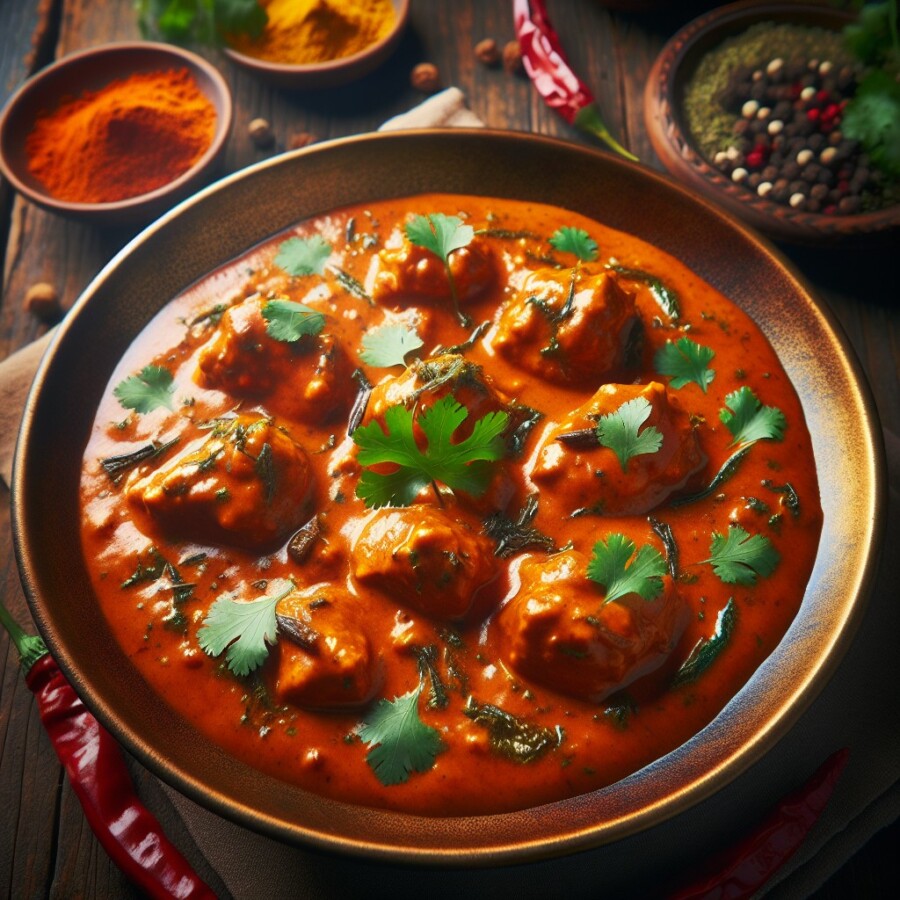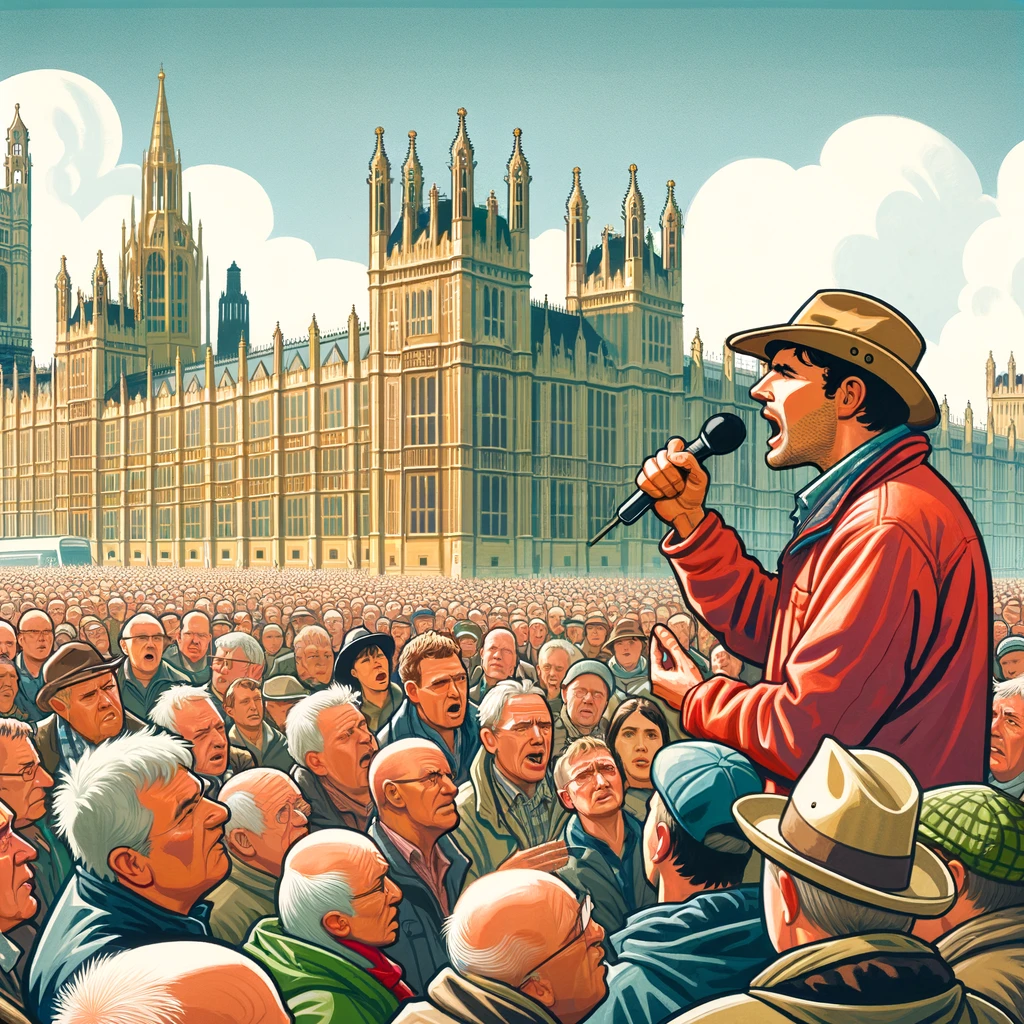Butter chicken, a popular Indian dish, has sparked a legal battle between two rival restaurants in Delhi. The lawsuit, filed in the Delhi High Court, involves families claiming to be linked to the famous Moti Mahal restaurant, which was founded in 1947. The argument is about who actually came up with the dish, with one family seeking damages and accusing the other of wrongly taking credit for it.
The story of butter chicken goes back to before India gained independence, when a man named Mokha Singh and his team from Peshawar started a restaurant in Delhi. It was at a small open-air diner in Daryaganj where butter chicken was created from leftover tikkas mixed with tomato gravy and butter. The dish became very popular, even attracting important people like India’s first prime minister, Jawaharlal Nehru, to the restaurant.
Kundan Lal Gujral played a significant role in the creation of butter chicken and was initially given credit for the recipe and the restaurant’s success. However, after he passed away, disagreements started over who owned the dish. The legal battle between the Gujral family and the owners of the rival Daryaganj chain is about who had a bigger part in inventing butter chicken and other dishes.
In the culinary world, fights over recognition and ownership of dishes are not rare, but they usually don’t affect customers who just enjoy the food. The history of dishes can sometimes be unclear, with many claims to their creation. What matters most is the quality of the food, rather than arguments over who first made it. The legal battle between Moti Mahal and Daryaganj might be hard to settle, as it involves finding out the true origins of a dish made many years ago. The court will probably use evidence and testimonies to resolve the dispute. Nonetheless, both restaurants are likely to keep doing well, as butter chicken’s popularity goes beyond ownership claims and remains a favorite among diners.
Original news source: Moti Mahal: India curry houses battle over butter chicken (BBC)
🎧 Listen:
Slow
Normal
Fast
📖 Vocabulary:
| 1 | lawsuit | A legal action brought in court. |
| 2 | independence | The condition of a nation, country, or state which exercises self-government, and usually sovereignty, over the territory. |
| 3 | diner | A small, casual restaurant. |
| 4 | gravy | A sauce, often made from the juices that come out from meat while it’s being cooked. |
| 5 | credit | Praise or approval given to someone for doing something or for something happening. |
| 6 | disagreements | Situations where people have different opinions and are possibly arguing. |
| 7 | recognition | The act of recognizing or being recognized, in particular. |
| 8 | culinary | Relating to cooking or kitchens. |
| 9 | customers | People who buy goods or services. |
| 10 | unclear | Not clear or certain because different descriptions or ideas are possible. |
| 11 | claims | Statements or declarations that something is the case. |
| 12 | quality | How good or bad something is. |
| 13 | origins | The point or place where something begins. |
| 14 | evidence | Anything that helps to prove that something is or is not true. |
| 15 | testimonies | Statements made in court to say that something is true. |
Group or Classroom Activities
Warm-up Activities:
– News Summary
Instructions: Divide the class into pairs or small groups. Give each group a few minutes to read the article. Then, ask them to work together to write a concise summary of the article, highlighting the main points and key details. Afterward, have each group share their summaries with the class.
– Opinion Poll
Instructions: Ask the class to form pairs or small groups. Give each group a list of questions related to the article, such as “Who do you think should be credited with inventing butter chicken?” or “Do you think it’s important to know the origins of a dish?” Have each group discuss the questions and record their opinions. Then, have a class discussion where groups can share their opinions and reasons behind them.
– Vocabulary Pictionary
Instructions: Write a list of key vocabulary words from the article on the board. Divide the class into teams. Give each team a vocabulary word and ask them to draw a picture that represents the word. The rest of the class must guess the word based on the drawing. Encourage teams to use their creativity and think of different ways to represent the words.
– Synonym Challenge
Instructions: Choose a few key vocabulary words from the article and write them on the board. Divide the class into pairs or small groups. Give each group a few minutes to come up with as many synonyms as they can for each word. Afterward, have each group share their synonyms with the class. Discuss the nuances and differences in meaning between the synonyms.
– Future Predictions
Instructions: Ask the class to imagine that they are food critics writing a review of the two rival restaurants involved in the legal battle. Have them write a short paragraph predicting what they think will happen in the court case and how it will impact the reputation and success of the restaurants. Afterward, encourage students to share their predictions with the class and discuss their reasoning behind them.
🤔 Comprehension Questions:
1. What is the legal battle in Delhi High Court about?
2. When was the Moti Mahal restaurant founded?
3. How was butter chicken created?
4. Who was initially given credit for the recipe and the restaurant’s success?
5. Why did disagreements start over who owned the dish?
6. Why don’t fights over recognition and ownership of dishes usually affect customers?
7. What is the court likely to use to resolve the dispute?
8. Why are both restaurants likely to keep doing well despite the legal battle?
Go to answers ⇩
🎧✍️ Listen and Fill in the Gaps:
Butter chicken, a popular Indian dish, has sparked a legal (1)______ between two rival restaurants in Delhi. The lawsuit, filed in the Delhi High (2)______, (3)______ families claiming to be linked to the (4)______ Moti Mahal restaurant, which was founded in 1947. The argument is about who actually came up with the dish, with one family seeking damages and accusing the other of wrongly taking credit for it.
The story of butter chicken goes back to before India gained independence, when a man named (5)______ Singh and his team from Peshawar started a restaurant in Delhi. It was at a small open-air diner in Daryaganj where butter (6)______ was created from leftover tikkas (7)______ with tomato gravy and butter. The dish became very popular, even attracting important people like India’s first prime minister, Jawaharlal Nehru, to the restaurant.
Kundan Lal (8)______ played a significant role in the creation of butter chicken and was initially given credit for the recipe and the restaurant’s success. However, after he passed away, disagreements (9)______ over who owned the dish. The legal battle between the Gujral family and the owners of the rival (10)______ chain is about who had a bigger part in inventing butter chicken and (11)______ dishes.
In the culinary world, fights over recognition and ownership of dishes are not rare, but they usually don’t affect customers who just enjoy the food. The history of dishes can sometimes be (12)______, with many claims to their creation. What (13)______ most is the quality of the food, rather than arguments over who first made it. The legal battle between Moti Mahal and Daryaganj might be hard to settle, as it involves finding out the true origins of a dish made many years ago. The court will probably use evidence and testimonies to resolve the dispute. Nonetheless, both (14)______ are likely to keep doing well, as butter chicken’s popularity goes beyond ownership claims and (15)______ a (16)______ among diners.
Go to answers ⇩
💬 Discussion Questions:
Students can ask a partner these questions, or discuss them as a group.
1. What is butter chicken and why is it so popular in India?
2. Have you ever tried butter chicken? If so, did you like it? Why or why not?
3. How would you feel if someone claimed credit for a dish you created? Why?
4. Do you think it’s important to know the true origins of a dish? Why or why not?
5. Have you ever been involved in a dispute with someone over something you created? What happened?
6. What other famous dishes do you know that have a disputed origin?
7. How do you think the court will determine who came up with butter chicken? Why?
8. Do you think the legal battle between the two restaurants will affect their popularity? Why or why not?
9. If you were the judge in this case, how would you decide who owns the rights to butter chicken? Why?
10. How do you think disputes over ownership of dishes can be prevented in the future?
11. Do you think it’s fair for one family to seek damages from another over a dish? Why or why not?
12. What do you think is more important: the quality of the food or the history of its creation? Why?
13. How would you feel if you were a customer of one of the restaurants involved in the dispute? Why?
14. Do you think it’s possible for two different people to come up with the same dish independently? Why or why not?
15. Why do you think butter chicken remains a favorite among diners despite the ownership claims?
Individual Activities
📖💭 Vocabulary Meanings:
Match each word to its meaning.
Words:
1. lawsuit
2. independence
3. diner
4. gravy
5. credit
6. disagreements
7. recognition
8. culinary
9. customers
10. unclear
11. claims
12. quality
13. origins
14. evidence
15. testimonies
Meanings:
(A) Praise or approval given to someone for doing something or for something happening.
(B) A small, casual restaurant.
(C) People who buy goods or services.
(D) Anything that helps to prove that something is or is not true.
(E) How good or bad something is.
(F) Relating to cooking or kitchens.
(G) The act of recognizing or being recognized, in particular.
(H) The condition of a nation, country, or state which exercises self-government, and usually sovereignty, over the territory.
(I) A legal action brought in court.
(J) A sauce, often made from the juices that come out from meat while it’s being cooked.
(K) Statements made in court to say that something is true.
(L) The point or place where something begins.
(M) Statements or declarations that something is the case.
(N) Situations where people have different opinions and are possibly arguing.
(O) Not clear or certain because different descriptions or ideas are possible.
Go to answers ⇩
🔡 Multiple Choice Questions:
1. What sparked the legal battle between two rival restaurants in Delhi?
(a) Butter chicken
(b) Naan bread
(c) Samosas
(d) Mango lassi
2. When was the famous Moti Mahal restaurant founded?
(a) 1955
(b) 1963
(c) 1947
(d) 1971
3. Who is credited with creating butter chicken?
(a) Kundan Lal Gujral
(b) Jawaharlal Nehru
(c) Moti Mahal
(d) Mokha Singh
4. Where was butter chicken created?
(a) Peshawar
(b) Daryaganj
(c) Mumbai
(d) Kolkata
5. Who is involved in the legal battle over the ownership of butter chicken?
(a) Gujral family and Daryaganj owners
(b) Nehru family and Moti Mahal owners
(c) Singh family and Peshawar owners
(d) Mahal family and Mumbai owners
6. What is the main focus in the culinary world according to the article?
(a) Ownership of dishes
(b) Restaurant popularity
(c) Price of the dishes
(d) Quality of the food
7. What might the court use to resolve the legal dispute between the restaurants?
(a) Social media polls
(b) Evidence and testimonies
(c) Coin toss
(d) Magic eight ball
8. What is the main reason why both restaurants are likely to continue doing well despite the legal battle?
(a) Ownership claims
(b) Price of the dishes
(c) Butter chicken’s popularity
(d) Restaurant location
Go to answers ⇩
🕵️ True or False Questions:
1. The court will likely use evidence and testimonies to settle the legal battle between Moti Mahal and Daryaganj.
2. Kundan Lal Gujral was initially credited with the recipe and restaurant’s success.
3. Disputes emerged following Gujral’s demise concerning ownership of the recipe.
4. Culinary disputes over dish recognition and ownership are quite common.
5. The dish was created from leftover tikkas mixed with tomato gravy and butter at a small open-air diner.
6. The conflict includes families linked to the renowned Moti Mahal eatery, founded in 1947.
7. Two food stalls in Delhi are competing in court over who truly invented butter chicken.
8. Butter chicken was invented before India gained independence by Mokha Singh and his team.
Go to answers ⇩
📝 Write a Summary:
Write a summary of this news article in two sentences.
Check your writing now with the best free AI for English writing!
Writing Questions:
Answer the following questions. Write as much as you can for each answer.
Check your answers with our free English writing assistant!
1. What is the legal battle between the two rival restaurants in Delhi about?
2. How was butter chicken created?
3. Who was initially given credit for the creation of butter chicken?
4. Why does the legal battle between the Gujral family and the owners of the Daryaganj chain matter?
5. How will the court likely settle the dispute between the two restaurants?
✅ Answers
🤔✅ Comprehension Question Answers:
1. What is the legal battle in Delhi High Court about?
The legal battle in the Delhi High Court is about who actually came up with the dish butter chicken.
2. When was the Moti Mahal restaurant founded?
The Moti Mahal restaurant was founded in 1947.
3. How was butter chicken created?
Butter chicken was created from leftover tikkas mixed with tomato gravy and butter.
4. Who was initially given credit for the recipe and the restaurant’s success?
Kundan Lal Gujral was initially given credit for the recipe and the restaurant’s success.
5. Why did disagreements start over who owned the dish?
Disagreements started over who owned the dish because after Kundan Lal Gujral passed away, there were disputes over who had a bigger part in inventing butter chicken and other dishes.
6. Why don’t fights over recognition and ownership of dishes usually affect customers?
Fights over recognition and ownership of dishes usually don’t affect customers because what matters most to them is the quality of the food, rather than arguments over who first made it.
7. What is the court likely to use to resolve the dispute?
The court is likely to use evidence and testimonies to resolve the dispute.
8. Why are both restaurants likely to keep doing well despite the legal battle?
Both restaurants are likely to keep doing well despite the legal battle because butter chicken’s popularity goes beyond ownership claims and remains a favorite among diners.
Go back to questions ⇧
🎧✍️✅ Listen and Fill in the Gaps Answers:
(1) battle
(2) Court
(3) involves
(4) famous
(5) Mokha
(6) chicken
(7) mixed
(8) Gujral
(9) started
(10) Daryaganj
(11) other
(12) unclear
(13) matters
(14) restaurants
(15) remains
(16) favorite
Go back to questions ⇧
📖💭✅ Vocabulary Meanings Answers:
1. lawsuit
Answer: (I) A legal action brought in court.
2. independence
Answer: (H) The condition of a nation, country, or state which exercises self-government, and usually sovereignty, over the territory.
3. diner
Answer: (B) A small, casual restaurant.
4. gravy
Answer: (J) A sauce, often made from the juices that come out from meat while it’s being cooked.
5. credit
Answer: (A) Praise or approval given to someone for doing something or for something happening.
6. disagreements
Answer: (N) Situations where people have different opinions and are possibly arguing.
7. recognition
Answer: (G) The act of recognizing or being recognized, in particular.
8. culinary
Answer: (F) Relating to cooking or kitchens.
9. customers
Answer: (C) People who buy goods or services.
10. unclear
Answer: (O) Not clear or certain because different descriptions or ideas are possible.
11. claims
Answer: (M) Statements or declarations that something is the case.
12. quality
Answer: (E) How good or bad something is.
13. origins
Answer: (L) The point or place where something begins.
14. evidence
Answer: (D) Anything that helps to prove that something is or is not true.
15. testimonies
Answer: (K) Statements made in court to say that something is true.
Go back to questions ⇧
🔡✅ Multiple Choice Answers:
1. What sparked the legal battle between two rival restaurants in Delhi?
Answer: (a) Butter chicken
2. When was the famous Moti Mahal restaurant founded?
Answer: (c) 1947
3. Who is credited with creating butter chicken?
Answer: (d) Mokha Singh
4. Where was butter chicken created?
Answer: (b) Daryaganj
5. Who is involved in the legal battle over the ownership of butter chicken?
Answer: (a) Gujral family and Daryaganj owners
6. What is the main focus in the culinary world according to the article?
Answer: (d) Quality of the food
7. What might the court use to resolve the legal dispute between the restaurants?
Answer: (b) Evidence and testimonies
8. What is the main reason why both restaurants are likely to continue doing well despite the legal battle?
Answer: (c) Butter chicken’s popularity
Go back to questions ⇧
🕵️✅ True or False Answers:
1. The court will likely use evidence and testimonies to settle the legal battle between Moti Mahal and Daryaganj. (Answer: True)
2. Kundan Lal Gujral was initially credited with the recipe and restaurant’s success. (Answer: True)
3. Disputes emerged following Gujral’s demise concerning ownership of the recipe. (Answer: False)
4. Culinary disputes over dish recognition and ownership are quite common. (Answer: False)
5. The dish was created from leftover tikkas mixed with tomato gravy and butter at a small open-air diner. (Answer: True)
6. The conflict includes families linked to the renowned Moti Mahal eatery, founded in 1947. (Answer: False)
7. Two food stalls in Delhi are competing in court over who truly invented butter chicken. (Answer: False)
8. Butter chicken was invented before India gained independence by Mokha Singh and his team. (Answer: True)
Go back to questions ⇧













